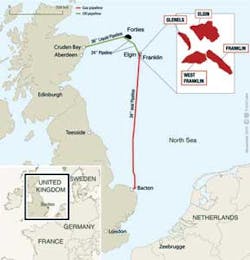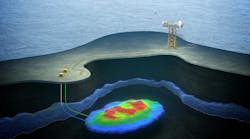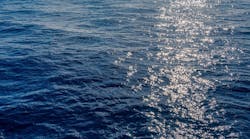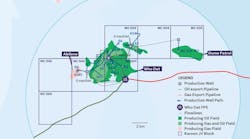Britain's government has agreed to a further consultation on a basin-wide UK offshore investment allowance in an attempt to soften the impact of the lower oil price. Chancellor George Osborne first announced the allowance last December and is expected to reveal additional measures in his annual budget statement this month.
Industry association Oil & Gas UK said the new arrangement should be accessible to all UK sector oil and gas investors, and should be designed to assist all types of activity that maximize recovery of the UK's hydrocarbon reserves while also extending the North Sea's productive lifespan. And tax relief needs to be enacted as soon as possible, added CEO Malcolm Webb. "With a significant amount of UK oil and gas production not even covering costs at a $50 oil price," he said, "the industry cannot carry the burden of a tax rate between 60% and 80%."
Two reports suggest UK field development at least is in reasonable shape. Last year capex across the sector reached $19 billion, according to analyst Wood Mackenzie. Almost one-third of the total was allocated to the Clair, Golden Eagle, Laggan, Mariner, and Schiehallion projects, with only Golden Eagle coming onstream at the tail-end of the year. UK production also stabilized after years of steep decline and could even rise in the short term, the analyst claimed.
Hannon Westwood estimated that UK fields produced collectively 600 MMboe last year, up from 520 MMboe, with ConocoPhillips' Jasmine ramping up and BP's Rhum gas/condensate field re-starting following a suspension imposed against Iranian partner IEOC. However, the total of 25 exploration and appraisal wells spudded in UK waters last year was the lowest since 1970, Hannon Westwood added.
Exploration will top the list of UK offshore budget cuts if the situation continues, according to Wood Mackenzie. Additionally, the $3.2-billion expenditure planned for pre-sanction development projects in the sector could be at risk, while the pressures on producing fields with high operating costs could potentially lead to shut-ins.
Cost squeeze could bring benefits, NPD claims
Norway also faces a period of readjustment following the recent downturn, but this could have positive consequences, according to the latest review by the Norwegian Petroleum Directorate (NPD). "The drop in prices could lead the industry to implement significant cost cuts," said director general Bente Nyland. "This is needed, although over the short term this could translate into a lower activity level."
Last year, four new fields came onstream offshore Norway and there were 56 exploratory well spuds across the sector, the third highest ever. These led to 22 discoveries with combined reserves of 110 MMcm of oil/condensate and 25-75 bcm of gas. Oil production rose last year for the first time since 2000 to 87.8 MMcm, 3% above the total for 2013, mainly due to new wells producing above expectations. Field regularity also improved, and there were instances of increased drilling on mature fields, notably at Snorre in the North Sea.
However, investments in petroleum activities across the shelf look set to dip by 15% this year from the $22.26 billion committed in 2014, and NPD forecasts a further decline of 8% to 2017, followed by a slight uptick in 2018. The association also estimates that 55% of Norway's oil and gas resources are yet to be produced, and this should provide the basis for sustained activity over the years ahead.
Norway opens southeastern Barents Sea for licensing
Next month marks the 50th anniversary of petroleum activities on the Norwegian shelf. On April 13, 1965, the government made available 278 blocks in the North Sea under the country's first licensing round. This year, the Petroleum and Energy Ministry has initiated the country's 23rd licensing round, focused largely on the Barents Sea, and has offered new licenses under the Awards in Pre-defined Areas (APA) 2014 Round.
The 23rd round acreage comprises 57 blocks and part-blocks, and includes 34 blocks in the southeastern Barents Sea, a region previously off-limits due to a dispute with Russia over the maritime boundary (recently resolved). This is also Norway's first new area opened for exploration since 1994. However, due to environmental considerations the window for exploration drilling will be restricted in areas close to the observed ice edge, which new data suggest runs north of the southeastern Barents Sea.
Under APA 2014, the Ministry has awarded 43 companies a total of 54 new production licenses, of which four are in the Barents Sea, 16 in the Norwegian Sea, and 34 in the North Sea. Seventeen represent additional acreage to existing licenses, while five are divided stratigraphically. Sissel Eriksen, the NPD's exploration director, said interest was greatest in areas that had brought recent discoveries, i.e. the central Norwegian North Sea and the Norwegian Sea, location of last year's Pil and Bue oil finds operated by VNG.
West Franklin Phase 2 finally goes onstream
Total has started gas/condensate production from the West Franklin Phase 2 project in the UK central North Sea. The West Franklin field, discovered in 2003, has reportedly the most extreme high-pressure/high-temperature conditions for any producing field on the UK continental shelf with a reservoir pressure of 1,100 bar (15,954 psi) and temperatures up to 190°C (374°F). Total began Phase 1 production in 2007 via two wells drilled from the Franklin field platform.
According to field analyst BritBoss, the Phase 2 start-up had been scheduled for late 2013, but had to be put back after drilling was disrupted following a gas leak at the Elgin field in spring 2012. This led to a suspension of operations at the Elgin/Franklin complex.
For the £640-million ($962-million) Phase 2 program, the company commissioned Rosetti and Saipem in Italy to construct a new 12-slot wellhead platform. Production, which will eventually reach 40,000 boe/d, heads through two 6.2-km (3.8-mi) pipelines integrated into a 30-in. bundle to the Elgin wellhead platform for subsequent delivery to the PUQ processing platform.







